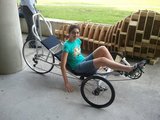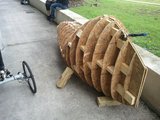
Let's see more pictures from the UCF College of Engineering and Computer Science Annual Senior Design Symposium on Renewable and Sustainable Energy -- which is so difficult to type that I shall call it the SDS from now on. Check out the 10-foot rocket from part 1!
Today, we've got two groups of seniors with aerodynamic farings for human-powered vehicles.

This team, which included mechanical and aerospace engineers, decided to participate in a human-powered vehicle race. They decided to go with a recumbent tricycle, which allows the rider to provide more power without worrying about balance.
They had a sponsor for the trike, so I don't know if it's custom-designed. I liked the controls on the ground under the rider's rump, though.

The big part of their project was the faring, though. They originally started with a mostly-cylindrical faring, which had a coefficient of drag (Cd) of 0.07. (Cd measures the force that resists your movement due to disturbing the air: how much your aerodynamics drag you back.) The problem was that the driver couldn't sit up, so couldn't use his back muscles. Or see.
So they modified it with a bump for the driver, as you can see from their mold. This reduced the Cd to 0.05.
They don't have much budget left, so they intend to build the faring out of foam or -- of all things -- aluminum spars and monocote. Yes, the stuff you cover model airplanes with.
Without the faring, they've been up to 26 mph. They also claim that their mold design is unique, in that it's made of wood. It reminds me of the way that airplane wings used to be laid out.

This group -- also mechanical and aerospace engineers -- custom-designed a recumbent bicycle and faring instead. With less rubber on the ground, they've got less rolling resistance... but the driver needs to keep the vehicle upright.
Their faring looks a lot like the trike team's, but narrower. It's made of carbon fiber, for weight, in multiple pieces. (Yes, they built their own vacuum table to form the faring. I know I took a picture, but I can't find anything but this one. More pictures next year, I promise.)
The pieces come apart at the top, so the driver can get in and out. There are holes at the bottom for the driver's feet, so he can keep it upright at stops. They've been up to 34 mph with the faring on.
Those who read on can see a life-size controller for an RC car!